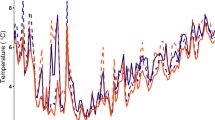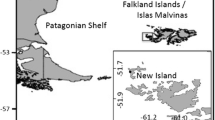Abstract
The seasonal energy dynamics of temperate fishes will likely be affected by climate change, especially during the winter. Few studies, however, have focused on winter. Fishes are more active in winter than previously thought, thus, an inquiry into the energetic contributions of winter foraging to the annual growth of fishes is needed given expected changes in winter conditions. We used stomach content data, total lipid analyses, and bioenergetics modeling to assess the effects of winter foraging on three species in Lake Champlain, Vermont, USA. We compared species in two thermal guilds, the cool-water species yellow perch (Perca flavescens) and two warm-water species, pumpkinseed (Lepomis gibbosus) and bluegill (Lepomis macrochirus). Our results indicate that winter energy dynamics likely depend on the thermal preference of individual fish species – the cool-water species foraged in all seasons whereas the two warm-water species foraged only in the open-water seasons. In addition, winter foraging provided sufficient energy for overwinter growth in cool-water species but not in warm-water species. Climate change will affect the seasonal energy dynamics that these species have evolved to survive winter conditions in temperate lakes. Thus, we expect climate change to affect individual survival and reproductive success.






Similar content being viewed by others
References
Amundsen, P.-A. & R. Knudsen, 2009. Winter ecology of Arctic charr (Salvelinus alpinus) and brown trout (Salmo trutta) in a subarctic lake, Norway. Aquatic Ecology 43: 765–775.
Amundsen, P. A., H. M. Gabler & F. Staldvik, 1996. A new approach to graphical analysis of feeding strategy from stomach contents data – modification of the Costello (1990) method. Journal of Fish Biology 48: 607–614.
Anderson, A. M., E. Mittag, B. Middleton, B. Vondracek & L. C. Ferrington, 2016. Winter diets of brown trout populations in southeastern Minnesota and the significance of winter-emerging invertebrates. Transactions of the American Fisheries Society 145: 206–220.
Barneche, D. R. & A. P. Allen, 2018. The energetics of fish growth and how it constrains food-web trophic structure. Ecology Letters 21: 836–844.
Block, B. D., B. A. Denfeld, J. D. Stockwell, G. Flaim, H. P. F. Grossart, L. B. Knoll, D. B. Maier, R. L. North, M. Rautio, J. A. Rusak, S. Sadro, G. A. Weyhenmeyer, A. J. Bramburger, D. K. Branstrator, K. Salonen & S. E. Hampton, 2019. The unique methodological challenges of winter limnology. Limnology and Oceanography: Methods 17: 42–57.
Brodersen, J., J. L. Rodriguez-Gil, M. Jonsson, L. A. Hansson, C. Bronmark, P. A. Nilsson, A. Nicolle & O. Berglund, 2011. Temperature and resource availability may interactively affect over-wintering success of juvenile fish in a changing climate. PLoS ONE 6: e24022.
Byström, P., J. Andersson, A. Kiessling & L. O. Eriksson, 2006. Size and temperature dependent foraging capacities and metabolism: consequences for winter starvation mortality in fish. Oikos 115: 43–52.
Clarke, A. & N. M. Johnston, 1999. Scaling of metabolic rate with body mass and temperature in teleost fish. Journal of Animal Ecology 68: 893–905.
Dabrowski, K., R. Ciereszko, A. Ciereszko, G. Toth, S. Christ, D. El-Saidy & J. Ottobre, 1996. Reproductive physiology of yellow perch (Perca flavescens): environmental and endocrinological cues. Journal of Applied Ichthyology 12: 139–148.
Deslauriers, D., S. R. Chipps, J. E. Breck, J. A. Rice & C. P. Madenjian, 2017. Fish bioenergetics 4.0: an R-based modeling application. Fisheries 42: 586–596.
Eckmann, R., 2004. Overwinter changes in mass and lipid content of Perca fluviatilis and Gymnocephalus cernuus. Journal of Fish Biology 65: 1498–1511.
Ejsmond, M. J., Ø. Varpe, M. Czarnoleski & J. Kozłowski, 2015. Seasonality in offspring value and trade-offs with growth explain capital breeding. American Naturalist 186: E111–E125.
Eloranta, A. P., H. L. Mariash, M. Rautio & M. Power, 2013. Lipid-rich zooplankton subsidise the winter diet of benthivorous Arctic charr (Salvelinus alpinus) in a subarctic lake. Freshwater Biology 58: 2541–2554.
Farmer, T. M., E. A. Marschall, K. Dabrowski & S. A. Ludsin, 2015. Short winters threaten temperate fish populations. Nature Communications 6: 7724.
Fernandes, T. & B. C. McMeans, 2019. Coping with the cold: energy storage strategies for surviving winter in freshwater fish. Ecography 42: 1–16.
Folch, J., M. Lees & G. S. Stanley, 1957. A simple method for the isolation and purification of total lipides from animal tissues. Journal of Biological Chemistry 226: 497–509.
Gerten, D. & R. Adrian, 2000. Climate-driven changes in spring plankton dynamics and the sensitivity of shallow polymictic lakes to the North Atlantic Oscillation. Limnology and Oceanography 45: 1058–1066.
Giacomini, H. C. & B. J. Shuter, 2013. Adaptive responses of energy storage and fish life histories to climatic gradients. Journal of Theoretical Biology 339: 100–111.
Hasler, A. D., 1945. Observations on the winter perch population of Lake Mendota. Ecology 26: 90–94.
Hasnain, S. S., C. K. Minns & B. J. Shuter, 2010. Key ecological temperature metrics for Canadian freshwater fishes. CCRR-17, Ontario Forest Research Institute, Peterborough, ON.
Hayden, B., C. Harrod & K. K. Kahilainen, 2013. The effects of winter ice cover on the trophic ecology of whitefish (Coregonus lavaretus L.) in subarctic lakes. Ecology of Freshwater Fish 22: 192–201.
Henderson, B. A. & S. J. Nepszy, 1994. Reproductive tactics of walleye (Stizostedion vitreum) in Lake Erie. Canadian Journal of Fisheries and Aquatic Sciences 51: 986–997.
Hoyle, J. A. & A. Keast, 1987. The effect of prey morphology and size on handling time in a piscivore, the largemouth bass (Micropterus salmoides). Canadian Journal of Zoology 65: 1972–1977.
Hurst, T. P., 2007. Causes and consequences of winter mortality in fishes. Journal of Fish Biology 71: 315–345.
Johnson, T. B. & D. O. Evans, 1991. Behaviour, energetics, and associated mortality of young-of-the-year white perch (Morone americana) and yellow perch (Perca flavescens) under simulated winter conditions. Canadian Journal of Fisheries and Aquatic Sciences 48: 672–680.
Kao, Y.-C., C. P. Madenjian, D. B. Bunnell, B. M. Lofgren & M. Perroud, 2015. Potential effects of climate change on the growth of fishes from different thermal guilds in Lakes Michigan and Huron. Journal of Great Lakes Research 41: 423–435.
Keva, O., P. Tang, R. Käkelä, B. Hayden, S. J. Taipale, C. Harrod & K. K. Kahilainen, 2019. Seasonal changes in European whitefish muscle and invertebrate prey fatty acid composition in a subarctic lake. Freshwater Biology 64: 1908–1920.
Magnuson, J. J., L. B. Crowder & P. A. Medvick, 1979. Temperature as an ecological resource. American Zoologist 19: 331–343.
Mariash, H. L., M. Cusson & M. Rautio, 2017. Fall composition of storage lipids is associated with the overwintering strategy of Daphnia. Lipids 52: 83–91.
McMeans, B. C., K. S. McCann, M. Humphries, N. Rooney & A. T. Fisk, 2015. Food web structure in temporally-forced ecosystems. Trends in Ecology & Evolution 30: 662–672.
McMeans, B. C., K. S. McCann, M. M. Guzzo, T. J. Bartley, C. Bieg, P. J. Blanchfield, T. Fernandes, H. C. Giacomini, T. Middel, M. D. Rennie, M. S. Ridgway & B. J. Shuter, 2020. Winter in water: differential responses and the maintenance of biodiversity. Ecology Letters. https://doi.org/10.1111/ele.13504.
Ogle, D., 2015. FSAmisc: miscellaneous functions for simple fisheries stock assessment methods. http://fishr.wordpress.com/, https://github.com/droglenc/FSAmisc, https://github.com/droglenc/FSA.
Pientka, B., 2017. Lake Champlain fish community monitoring. Vermont Fish and Wildlife Dept. Annual Report. F-35-R-19, Essex Junction, VT.
R Core Team, 2018. R: a language and environment for statistical computing. R Foundation for Statistical Computing, Vienna, Austria. URL https://www.R-project.org/.
Schoener, T. W., 1970. Nonsynchronous spatial overlap of lizards in patchy habitats. Ecology 51: 408–418.
Schreiner, D. R., & S. T. Schram. 2000. Lake Superior fish aging manual. Great Lakes Fishery Commission, Miscellaneous Publication, Ann Arbor, Michigan.
Selch, T. M. & S. R. Chipps, 2007. The cost of capturing prey: measuring largemouth bass (Micropterus salmoides) foraging activity using glycolytic enzymes (lactate dehydrogenase). Canadian Journal of Fisheries and Aquatic Sciences 64: 1761–1769.
Shannon, C. E. & W. Weaver, 1998. The mathematical theory of communication. University of Illinois press.
Sharma, S., K. Blagrave, J. J. Magnuson, C. M. O’Reilly, S. Oliver, R. D. Batt, M. R. Magee, D. Straile, G. A. Weyhenmeyer & L. Winslow, 2019. Widespread loss of lake ice around the Northern Hemisphere in a warming world. Nature Climate Change 9: 227–231.
Shuter, B., A. Finstad, I. Helland, I. Zweimüller & F. Hölker, 2012. The role of winter phenology in shaping the ecology of freshwater fish and their sensitivities to climate change. Aquatic Sciences 74: 637–657.
Speers-Roesch, B., T. Norin & W. R. Driedzic, 2018. The benefit of being still: energy savings during winter dormancy in fish come from inactivity and the cold, not from metabolic rate depression. Proc. Biol. Sci. 285: 20181593.
Stockwell, J. D., D. L. Yule, T. R. Hrabik, M. E. Sierszen & E. J. Isaac, 2014. Habitat coupling in a large lake system: delivery of an energy subsidy by an offshore planktivore to the nearshore zone of Lake Superior. Freshwater Biology 59: 1197–1212.
Wallace, R. K., 1981. An assessment of diet-overlap indexes. Transactions of the American Fisheries Society 110: 72–76.
Wilkins, P. D., 2019. Spatial and seasonal comparisons of growth of wild and stocked juvenile lake trout in Lake Champlain. Masters thesis. University of Vermont, Burlington, VT.
Woolway, R. I. & C. J. Merchant, 2019. Worldwide alteration of lake mixing regimes in response to climate change. Nature Geoscience 12: 271–276.
Zia, A., A. Bomblies, A. Schroth, C. Koliba, P. Isles, Y. Tsai, I. Mohammed, G. Bucini, P. Clemins, S. Turnbull, M. Rodgers, A. Hamed, B. Beckage, J. Winter, C. Adair, G. Galford, D. Rizzo & J. Van Houten, 2016. Coupled impacts of climate and land use change across a river-lake continuum: insights from an integrated assessment model of Lake Champlain’s Missisquoi Basin, 2000-2040. Environmental Research Letters 11.
Acknowledgements
Special thanks to Amanda Hass and Alisha Secor for their help with field and laboratory work. I would also like to thank Jacob Crawford, Matt Futia, Allison Hrycik, Dan Delucia, and Undraa Irvin for their assistance. We also thank two anonymous reviewers who greatly improved our manuscript prior to publication. We acknowledge the use of temperature data from Vermont Established Program to Stimulate Competitive Research’s (VT EPSCoR) Basin Resilience to Extreme Events (BREE) award (NSF Award# OIA-1556770). This work was made possible with funds made available to Lake Champlain research by Senator Patrick Leahy through the Great Lakes Fisheries Commission, and the Explorer’s Club.
Author information
Authors and Affiliations
Corresponding author
Additional information
Handling editor: Antti P. Eloranta
Publisher's Note
Springer Nature remains neutral with regard to jurisdictional claims in published maps and institutional affiliations.
Electronic supplementary material
Below is the link to the electronic supplementary material.
Rights and permissions
About this article
Cite this article
Block, B.D., Stockwell, J.D. & Marsden, J.E. Contributions of winter foraging to the annual growth of thermally dissimilar fish species. Hydrobiologia 847, 4325–4341 (2020). https://doi.org/10.1007/s10750-020-04428-2
Received:
Revised:
Accepted:
Published:
Issue Date:
DOI: https://doi.org/10.1007/s10750-020-04428-2




